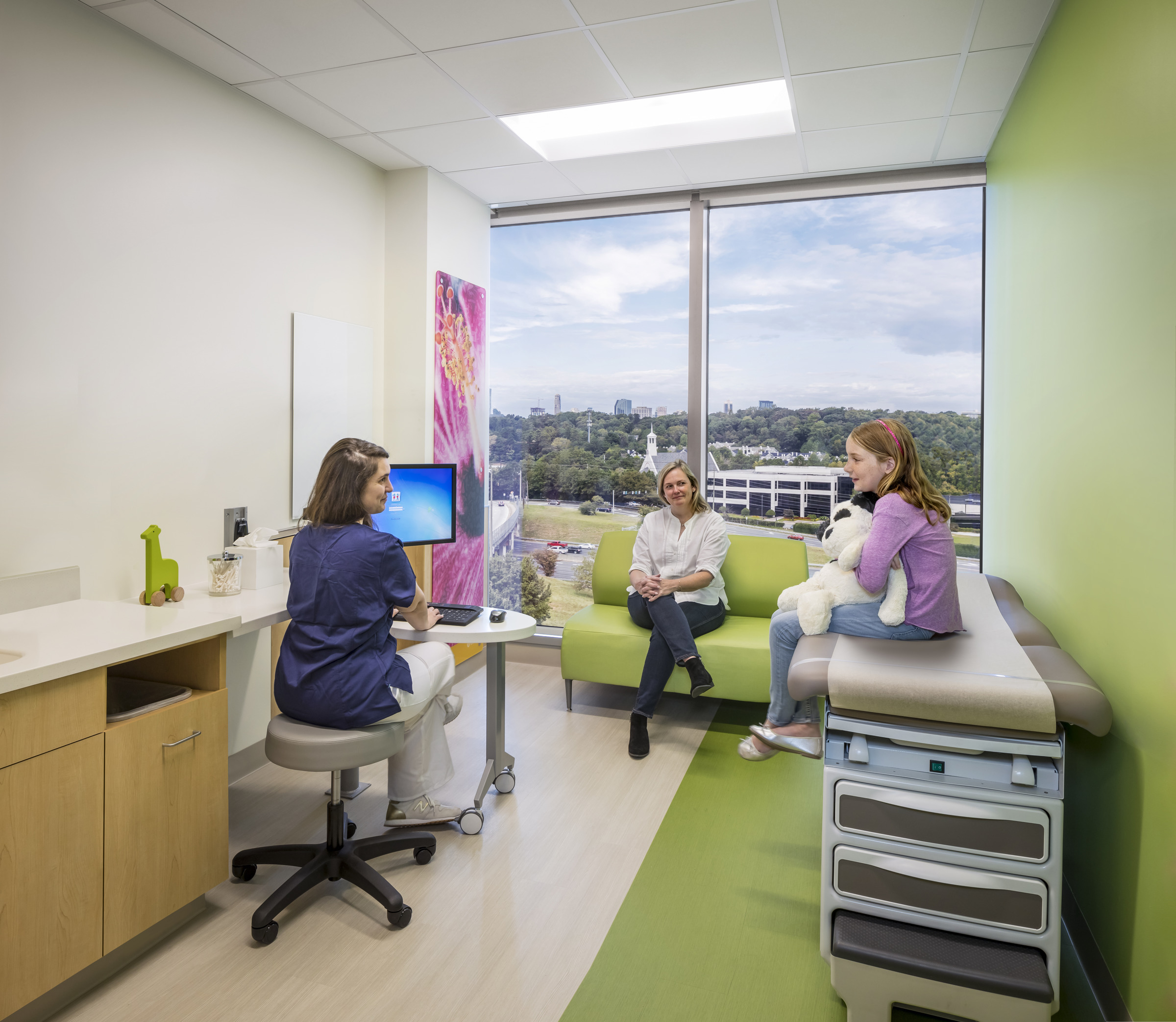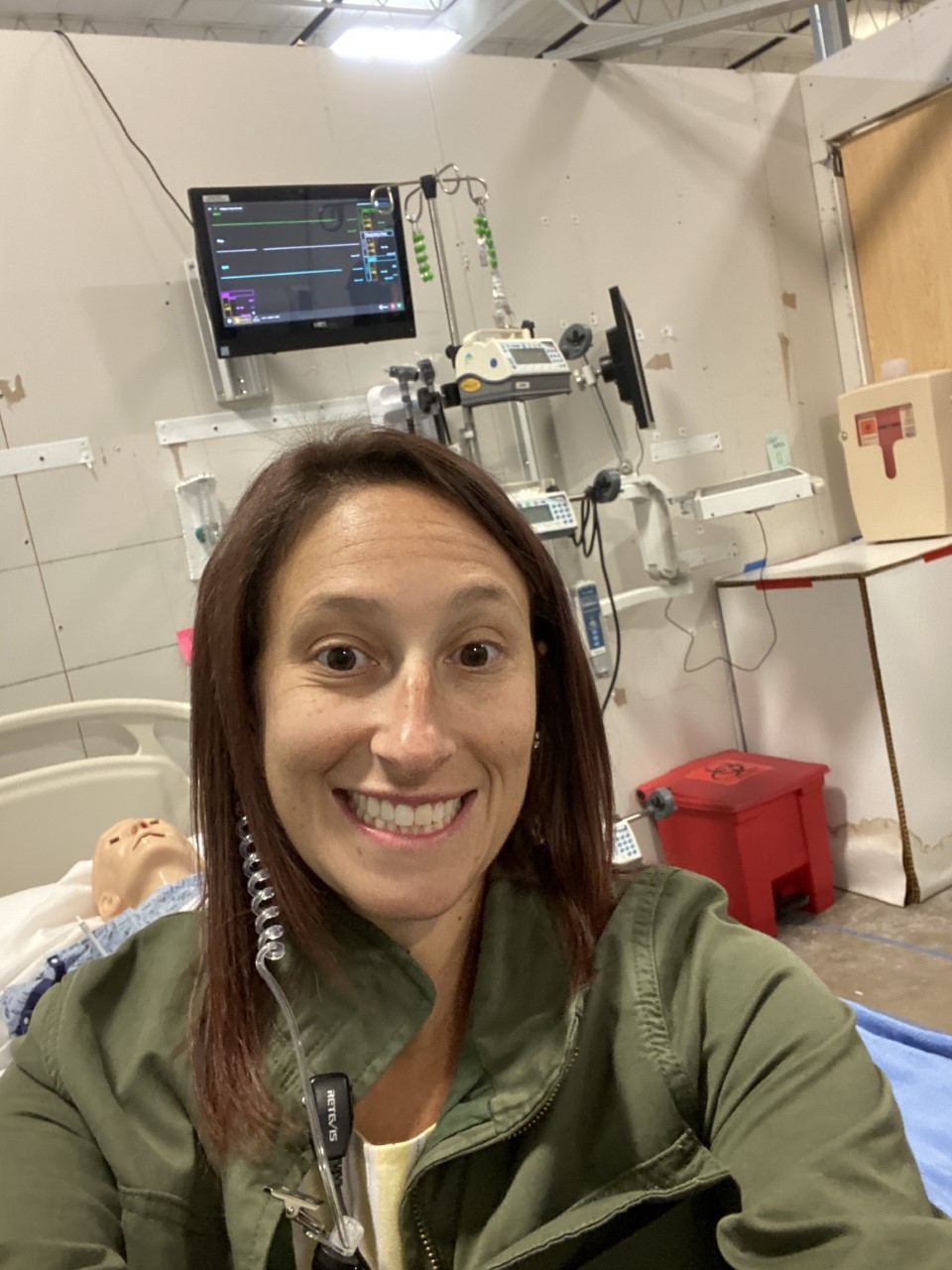
Health Partner Insights is a continuing series where we tap the collective wisdom of our healthcare clients on current challenges, trends, and technologies.
A conversation with pediatrician Nora Colman, MD, FAAP, assistant professor of pediatrics at Emory and pediatric critical care medicine physician at Children’s Healthcare of Atlanta.
As a physician advisor at Page, Colman serves as a liaison to assist clinician owners in seeing care delivery through the lens of design and helps architects and designers understand clinician needs as they relate to the physical environment. She’s also able to assist with simulation-based testing if requested by a client.
“The delivery of healthcare is complex. Think about the systems we work in, the built environment, all the people and tech, the variables that impact how we take care of patients,” Colman says. “That’s where my passion for design, safety, and quality care have merged with my interest in simulation.”
The Partnership: Page teams have worked on multiple projects for Children’s Healthcare of Atlanta and Emory University, among them Children’s Center for Advanced Pediatrics, the Arthur M. Blank Children’s Hospital (under construction), Winship Cancer Research Institute, the Shared Resources Hub laboratory at Winship, and the Science and Mathematics Center at Oxford College of Emory.
Three Things to Know About Simulation, Safety, and Pediatric Healthcare:
1. Just because an event is unexpected doesn’t mean you can’t prepare for it. When Colman was chief resident at the University of Florida, she was already passionate about simulation and its potential to improve patient care. “Then, one day, we saw a patient at clinic who was very sick. You could tell something was really wrong,” she says. Still, when a code blue alarm went off later that afternoon, after the patient arrested, the staff was not prepared and didn’t have the right equipment. “I realized we needed to do training on resuscitation, using sim as the teaching modality,” she says.
2. Take healthcare delivery spaces for a test run. “When we were building a new pediatric hospital [Children’s Arthur M. Blank Hospital in Atlanta], I saw it as a great opportunity to do simulation testing, to think about how that environment intersects with everything and everyone and how we make things safer by designing a safer building,” Colman says. Children’s had rented a warehouse and created one of the largest full-scale cardboard hospital mock-ups in the country so clinicians like Colman could test out operations: “You have to interact with the space to really understand how care is performed.”
3. Good healthcare design helps staff make better decisions. One of the ways to support hospital staff is to design a built environment that supports taking the right action. For instance, it is essential that staff be able to concentrate while in medication rooms, says Colman, where interruptions/interactions are a huge contributing factor to medication-related errors. A design solution? Narrow the hallway to discourage gatherings and conversations and relocate common areas nearby.

A Deeper Dive
Healthcare delivery requires a complex system in which providers interact with patients, technology, equipment, and the physical environment. These interactions are strongly linked to patient and employee safety.
“We need to think differently about healthcare facilities,” says Colman. “We now have a culture that is different from what we’ve seen before.”
COVID-19 challenged hospital standards for safety, PPE, air quality, and sterilization, and demanded so much from frontline workers that many left. “Since the pandemic, there has been high staff turnover, which means we have to constantly train on the same concepts over and over,” she says. “We have to fix the system, which includes the built environment.”
“Architects have to design spaces that fit everyone’s needs, but everyone’s needs are different. There are a lot of nuances in care delivery even within the same hospital,” she says. “We need to start with people and create design around them. Design can drive human behavior.”
Surroundings matter
Advances in hospital design should take into consideration how spaces impact not only patients, but healthcare workers as well.
One problem, says Colman, is that clinicians still purport not to care about their workplace surroundings. “They say, we don’t care about the color of the walls or, it doesn’t matter that there are no windows, I’ll be fine working in a dungeon,” she says, laughing.
“We’re all used to healthcare designers trying to create spaces that engage and comfort patients and families, that are not so stark and bare,” she says. “Clinicians are starting to see how the environment affects them as well, from having a place to stash their personal items to how far they have to walk to get supplies. The built environment impacts staff satisfaction, burnout, and retention.”

‘A magnet to me’
Colman became certified at 16 to become an EMT and worked on the ambulance corps. She volunteered in hospitals and went on to major in neuroscience at Muhlenberg College and get an MD at Rutgers Robert Wood Johnson Medical School. After matching for residency at the University of Florida, she worked in the pediatric ICU and became fascinated by pediatric critical care. “The acuity and complexity of patients, the breadth of disease. I couldn’t hide behind a computer, it was all patient-facing, interacting with a team in a dynamic environment,” she says. “That was a magnet for me.”
She began focusing her research on quality improvement and simulation and completed a pediatric critical care fellowship and a simulation fellowship at Emory/Children’s Healthcare of Atlanta. Colman has since used sim training to improve team performance in the pediatric ICU and the cardiac ICU, to teach new skills and algorithms, and to reduce medical errors.
Simulation can also provide feedback on how well staff is functioning in a new healthcare space through post-construction, pre-occupancy clinical systems testing. The advantage: discovering problems and correcting them before the first patient is admitted.
“Decisions made during the planning process, such as layouts or placement of supplies and fixtures, can have unintentional and significant downstream effects that may lead to hospital-acquired conditions, medical errors, adverse events, system deficiencies, compromised employee safety, and poor job satisfaction,” she wrote in a recent article for Healthcare Design magazine with Dr. Kiran Hebbar, medical director of safety and simulation at Children’s Healthcare of Atlanta and professor of pediatrics at Emory.
Keeping kids alive longer
“Healthcare architects and the healthcare community need devoted guidelines and standards for pediatric healthcare. Everything is cut and pasted from adult guidelines and standards. We need to focus on creating guidelines specific to pediatric spaces.” – Dr. Nora Colman
Over the past decade, the acuity and complexity of the pediatric patient population has changed. “We are seeing more and more chronic, high-complexity, technology-dependent patients,” Colman says. “Children are spending prolonged periods of time in the hospitals, some staying more than a year. Because we can do so much to keep kids alive longer, hospitals have a larger case load of chronic patients.”
This leads to considering how to support patients and families who remain in the hospital for long periods of time. “They require different kinds of spaces than acute-care patients,” she says. “A big challenge in Georgia is that there is no long-term technology facility for children under 18 whose families do not have means to care for them at home. These patients then unfortunately stay in the hospital for even longer periods of time. This all impacts PICU capacity.”
Healthcare spaces must evolve to meet the demands and changing technologies. “Home health is an option,” Colman says, “but there aren’t enough resources for the support of those families. It is really challenging.”